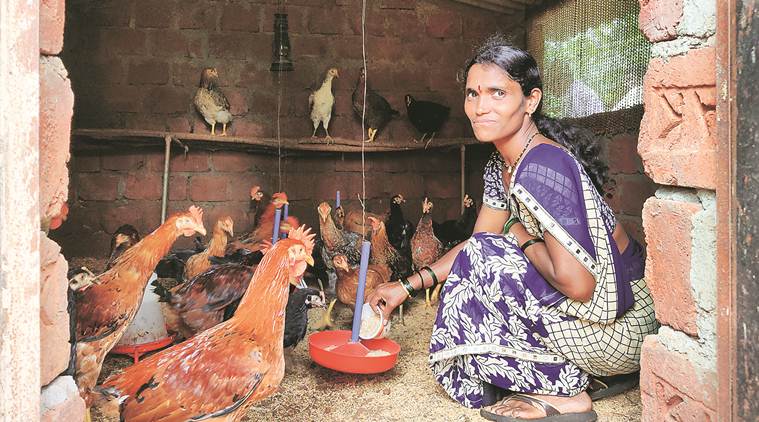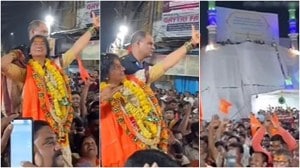- India
- International
In Raigad, Maharashtra — women take up poultry farming, stop migration
Last year, around 2,200 families were surveyed in Mahad and 700 economically poor, migration affected women, several of them widows, were selected to do poultry farming.
 Shubhangi Rajaram in Vinhere village has sold 40 hens. (Express)
Shubhangi Rajaram in Vinhere village has sold 40 hens. (Express)
A poultry farming programme in rural Raigad for below poverty line women is ensuring a steady income and alternate livelihood source in the paddy-dominated terrain. The region witnesses seasonal migration that has increased due to erratic rainfall pattern over the last few years. While the project was initiated by NGO Childfund India, Raigad district officials are handholding the vaccination of poultry and in providing the list of possible beneficiaries for the programme.
On a hillock in Vinhere village, Shubhangi Rajaram started poultry farming six months ago. She is counting days before her hens will start laying eggs. Having so far sold 40 hens for Rs 10,000, Shubhangi (35) says she earns more than she ever did from domestic work in Mahad, a hilly region in Raigad.
Like Rajaram, 700 women in Mahad are indulging in poultry farming. Each paid Rs 3,000 to get a shed for 100 chicks constructed last year. They underwent a two-day training program under experts. Dilip Khambate, project manager in Raigad, said in Mahad 90 per cent families have at least one member who migrates to Pune or Mumbai for additional income. During monsoons, they return to Raigad for paddy cultivation, but with scanty rainfall in last three years, the rice cultivation has been badly hit.
Last year, around 2,200 families were surveyed in Mahad and 700 economically poor, migration affected women, several of them widows, were selected to do poultry farming. “We helped them construct a shed and gave them 100 chicks, all 21 days old and fully vaccinated. Thirty kg of poultry feed was given free to start poultry farming,” Khambate said.
Raigad’s deputy commissioner of animal husbandry department, Dr Subhash Mhaske, said they provided support in vaccination of chicks.

Shubhangi’s husband had migrated to Mumbai to work at a press unit. Two years ago, the factory shut. “He was jobless. My income was not enough to feed our two kids,” she said. Last June, the landless couple was informed about the poultry project. They borrowed Rs 5,000 and bought a 100 square ft land. Today, Shubhangi does three daily visits to feed the chicks and sweep the shed. Locals from nearby villages come to buy meat at her shed. “I sell a hen for Rs 250,” she says, then adds, “Now even my kids eat chicken regularly”. She has also started brinjal, ladyfinger and cucumber plantation nearby to grow enough to feed her family.
The chicks take at least 70 days to gain over a kg weight before they are ready to be sold, and 80 days before they start laying eggs. Dapoli, 40 km away, provides a good market as several tourists have a taste for country chicken.
Poultry farming in this water-scarce region has become a profitable revenue model as these women need only 2-5 litres per day for 100 chicks.
“Poultry farming has been carried in Vidarbha and Marathwada pockets too. In Raigad, we are seeing it as a good income source for women. This will prevent migration,” said Mhaske, deputy commissioner of animal husbandry. He added the government has also started similar poultry program is 45 tribal villages with over 840 beneficiaries.
Neelam Makhejani, country director of Childfund, said they plan to scale up to include 5,000 women.
Arvind Sutar, who coordinates with vendors to sell the hen, said there are 44 vendors in the region where chicken at the wholesale rate of Rs 125 per kg can be sold. “The women plan to use self-help groups to sell the hens in neighbouring villages to fetch better prices”.
Apr 18: Latest News
- 01
- 02
- 03
- 04
- 05






































